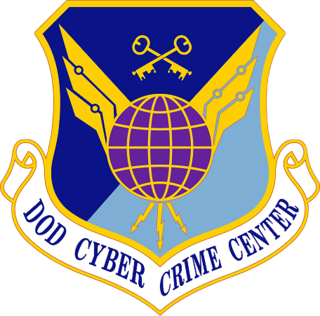
Computer security, cybersecurity, digital security, or information technology security is the protection of computer systems and networks from attacks by malicious actors that may result in unauthorized information disclosure, theft of, or damage to hardware, software, or data, as well as from the disruption or misdirection of the services they provide.

The SANS Institute is a private U.S. for-profit company founded in 1989 that specializes in information security, cybersecurity training, and selling certificates. Topics available for training include cyber and network defenses, penetration testing, incident response, digital forensics, and auditing. The information security courses are developed through a consensus process involving administrators, security managers, and information security professionals. The courses cover security fundamentals and technical aspects of information security. The institute has been recognized for its training programs and certification programs. Per 2021, SANS is the world’s largest cybersecurity research and training organization. SANS is an acronym for SysAdmin, Audit, Network, and Security.

The National Cyber Security Division (NCSD) is a division of the Office of Cyber Security & Communications, within the United States Department of Homeland Security's Cybersecurity and Infrastructure Security Agency. Formed from the Critical Infrastructure Assurance Office, the National Infrastructure Protection Center, the Federal Computer Incident Response Center, and the National Communications System, NCSD opened on June 6, 2003. The NCSD mission is to collaborate with the private sector, government, military, and intelligence stakeholders to conduct risk assessments and mitigate vulnerabilities and threats to information technology assets and activities affecting the operation of the civilian government and private sector critical cyber infrastructures. NCSD also provides cyber threat and vulnerability analysis, early warning, and incident response assistance for public and private sector constituents. NCSD carries out the majority of DHS’ responsibilities under the Comprehensive National Cybersecurity Initiative. The FY 2011 budget request for NCSD is $378.744 million and includes 342 federal positions. The current director of the NCSD is John Streufert, former chief information security officer (CISO) for the United States Department of State, who assumed the position in January 2012.
Software assurance (SwA) is a critical process in software development that ensures the reliability, safety, and security of software products. It involves a variety of activities, including requirements analysis, design reviews, code inspections, testing, and formal verification. One crucial component of software assurance is secure coding practices, which follow industry-accepted standards and best practices, such as those outlined by the Software Engineering Institute (SEI) in their CERT Secure Coding Standards (SCS).
Information security standards or cyber security standards are techniques generally outlined in published materials that attempt to protect the cyber environment of a user or organization. This environment includes users themselves, networks, devices, all software, processes, information in storage or transit, applications, services, and systems that can be connected directly or indirectly to networks.
An information assurance vulnerability alert (IAVA) is an announcement of a computer application software or operating system vulnerability notification in the form of alerts, bulletins, and technical advisories identified by US-CERT, https://www.us-cert.gov/ US-CERT is managed by National Cybersecurity and Communications Integration Center (NCCIC), which is part of Cybersecurity and Infrastructure Security Agency (CISA), within the U.S. Department of Homeland Security (DHS). CISA, which includes the National Cybersecurity and Communications Integration Center (NCCIC) realigned its organizational structure in 2017, integrating like functions previously performed independently by the U.S. Computer Emergency Readiness Team (US-CERT) and the Industrial Control Systems Cyber Emergency Response Team (ICS-CERT). These selected vulnerabilities are the mandated baseline, or minimum configuration of all hosts residing on the GIG. US-CERT analyzes each vulnerability and determines if it is necessary or beneficial to the Department of Defense to release it as an IAVA. Implementation of IAVA policy will help ensure that DoD Components take appropriate mitigating actions against vulnerabilities to avoid serious compromises to DoD computer system assets that would potentially degrade mission performance.

The Defense Technical Information Center is the repository for research and engineering information for the United States Department of Defense (DoD). DTIC's services are available to DoD personnel, federal government personnel, federal contractors and selected academic institutions. The general public can access unclassified information through its public website.
ManTech International Corporation is an American defense contracting firm based in Herndon, Virginia. It was co-founded in 1968 by Franc Wertheimer and George J. Pedersen. The company uses technology to help government and industry clients. The company name "ManTech" is a portmanteau formed through the combination of "management" and "technology."
The Data & Analysis Center for Software (DACS) was one of several United States Department of Defense (DoD) sponsored Information Analysis Centers (IACs), administered by the Defense Technical Information Center (DTIC). It was managed by the U.S. Air Force Research Laboratory (AFRL) and operated by Quanterion Solutions Inc. under a long term DoD contract. This organization was consolidated into the Cyber Security and Information Systems Information Analysis Center (CSISAC).

DoDTechipedia is a wiki developed by the United States Department of Defense (DoD), to facilitate increased communication and collaboration among DoD scientists, engineers, program managers, acquisition professionals and operational warfighters. DoDTechipedia is a living knowledge base that reduces duplication of effort, encourages collaboration among program areas and connects capability providers with technology developers. DoDTechipedia runs on Confluence wiki engine, unlike a number of MediaWiki-based government wikis like Diplopedia and Bureaupedia.

The Department of Defense Cyber Crime Center (DC3) is designated as a Federal Cyber Center by National Security Presidential Directive 54/Homeland Security Presidential Directive 23, as a Department of Defense (DoD) Center Of Excellence for Digital and Multimedia (D/MM) forensics by DoD Directive 5505.13E, and serves as the operational focal point for the Defense Industrial Base (DIB) Cybersecurity program. DC3 operates as a Field Operating Agency (FOA) under the Inspector General of the Department of the Air Force.
Control system security, or industrial control system (ICS) cybersecurity, is the prevention of interference with the proper operation of industrial automation and control systems. These control systems manage essential services including electricity, petroleum production, water, transportation, manufacturing, and communications. They rely on computers, networks, operating systems, applications, and programmable controllers, each of which could contain security vulnerabilities. The 2010 discovery of the Stuxnet worm demonstrated the vulnerability of these systems to cyber incidents. The United States and other governments have passed cyber-security regulations requiring enhanced protection for control systems operating critical infrastructure.
Information Assurance Technology Analysis Center (IATAC) is a United States Department of Defense (DoD) Government Organization. IATAC is an Information Assurance and Cyber Security (CS) Information Analysis Center (IAC), which is administered by the Defense Technical Information Center (DTIC).
IEC 62443 is an international series of standards that address cybersecurity for operational technology in automation and control systems. The standard is divided into different sections and describes both technical and process-related aspects of automation and control systems cybersecurity.
A cyberattack is any offensive maneuver that targets computer information systems, computer networks, infrastructures, personal computer devices, or smartphones. An attacker is a person or process that attempts to access data, functions, or other restricted areas of the system without authorization, potentially with malicious intent. Depending on the context, cyberattacks can be part of cyber warfare or cyberterrorism. A cyberattack can be employed by sovereign states, individuals, groups, societies or organizations and it may originate from an anonymous source. A product that facilitates a cyberattack is sometimes called a cyber weapon. Cyberattacks have increased over the last few years. A well-known example of a cyberattack is a distributed denial of service attack.
In cybersecurity, cyber self-defense refers to self-defense against cyberattack. While it generally emphasizes active cybersecurity measures by computer users themselves, cyber self-defense is sometimes used to refer to the self-defense of organizations as a whole, such as corporate entities or entire nations. Surveillance self-defense is a variant of cyber self-defense and largely overlaps with it. Active and passive cybersecurity measures provide defenders with higher levels of cybersecurity, intrusion detection, incident handling and remediation capabilities. Various sectors and organizations are legally obligated to adhere to cyber security standards.
Code Dx, Inc. was an American software technology company active from 2015 to 2021. The company's flagship product, Code Dx, is a vulnerability management system that combines and correlates the results generated by a wide variety of static and dynamic testing tools. In 2021, the company was acquired by Synopsys.
Assured Compliance Assessment Solution (ACAS) is a software set of information security tools used for vulnerability scanning and risk assessment by agencies of the United States Department of Defense (DoD). It performs automated vulnerability scanning and device configuration assessment. ACAS was implemented by the DoD in 2012, with contracts awarded to Tenable, Inc. (then known as Tenable Network Security) and Hewlett Packard Enterprise Services to improve cybersecurity within the DoD. It is mandated by regulations for all DoD agencies and is deployed via download. Part of the ACAS software monitors passive network traffic, new network hosts, and applications that are vulnerable to compromise. It also generates required reports and data that are remotely accessible, with a centralized console, and is Security Content Automation Protocol (SCAP) compliant. The Defense Information Systems Agency's Cyber Development (CD) provides program management and support in the deployment of ACAS. The Army's Systems Engineering and Integration Directorate said in 2016 that ACAS gives the Army "a clear, specific and timely picture of cyber vulnerabilities and how they are being addressed. Not only does the technology streamline processes at the operator level, it also enables broader goals such as the Cybersecurity Scorecard and automated patching for improved mission assurance."
William "Chuck" Easttom II is an American computer scientist specializing in cyber security, cryptography, quantum computing, and systems engineering.

Kamal Toufic Jabbour is a retired member of the Scientific and Professional Career Service of the United States of America SES having served for 15 years as the United States Air Force Senior Scientist for Information Assurance. He is also the Founding Director of the Advanced Course in Engineering Cyber Security Boot Camp for ROTC cadets, developer of the Bachelor of Science in Cyber Engineering, and designer of the trademarked Cyber Blue Book for cyber vulnerability assessment of Air Force missions and weapons.






